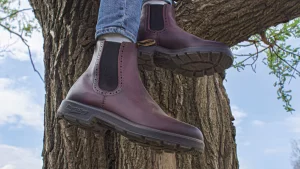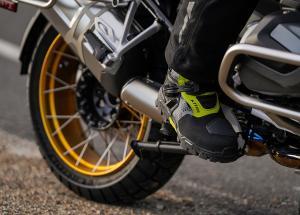Is there a footwear category “overland”? If there were, it would be synonymous for an everyday shoe, characterised by strong uppers and a rugged sole. First and foremost, the shoes must be comfortable to wear for extended periods, regardless of the circumstances. Most likely pulled on in the morning and taken off late at night, they will dance the pedals in a truck, hike, wade through water, stamp out fires, kick rocks, branches and tree trunks out of the way, and protect against ice, rain, humidity and Lut-like desert temperatures.
Overland shoes don’t need to win any prizes for beauty…they are functional and should last years, or even decades.
COURTENEY BOOTS
Founded in 1992 by John and Gale Rice, Courteney Boots derives its name from the British explorer and conservationist Frederick Courteney Selous. Located in Bulawayo, Zimbabwe, the company continues to make each pair of boots by hand, using gameskins from sustainable sources.
Craftsmen use selected ostrich, buffalo, antelope, crocodile, hippopotamus, and kudu leather for the range of shoes and boots. The soles are manufactured in-house from natural rubber, and the company imports the finest threads, adhesives.
Contrary to typical business goals to maximise growth and volume, Courteney Boots manufactures just 30 pairs per day…to order, using methods and machines first introduced four decades ago. Each pair of shoes takes three weeks to complete and there is a three-month waiting list.
The all female management team is proud of their work atmosphere and the fact that their employees span several generations of the same families.
Typical customers include conservation experts, adventurers, safari guides and photographers.
THE SELOUS
When I opened the cardboard box, there was more to its contents than just my pair of Selous. A large cotton bag, to store the boots themselves, and a smaller pouch with care products including a brush, polish and a spare set of laces.
This pair is made from grainy brown buffalo hide. If you prefer something a little more ostentacious, there is a two-tone alternative which uses a combination of buffalo and ostrich leather.
Even though the buffalo hide is thick and strong, it was surprisingly supple for a new boot and, as I later found out, quickly adapted to the shape of my foot. The breaking-in period was short and without any pressure points or blisters.
All the seams are double-stitched and those holding the uppers to the leather mid soles, are positioned to protect them against rock abrasions. For further reinforcement, a brass rivet on the leading edge of the eyestay (which houses the lacing system) minimises the risk of tears. As for the lacing system itself, the brass eyelets, D-rings and hooks are strong and well-dimensioned for the thick laces.
The natural rubber sole, characteristic for Courteney footwear, is robust and reminiscent of a ZXL tyre pattern. The deep, firm tread remains flexible and is a recipe for sure footing on any terrain. I haven’t a clue how many kilometres I’ve covered in the last 12 months, but they show no signs of wear—and if they do, re-soling isn’t out of the question.
COMFORT AND PROTECTION
Made of the softest leather, the tongue won’t cause any pressure points and the soft collar fits snuggly above the ankle to prevent twigs, small stones or creatures getting inside.
As far as breathability and waterproofing is concerned, a regularly maintained leather boot or shoe is going to tick both boxes. However, the quality of the hide makes a big difference. Outdoor footwear is destined to get really wet at some stage. Thicker, pre-treated leather will cope better than most thinner, cost-driven alternatives which may crack. I’ve subjected the Selous to some of the worst European downpours, mud baths and scorching summer temperatures without any negative side-effects.
UNIQUE
Because every pair of Courteney boots is unique, each has a serial number stamped into a patch on the heel cap. This is a bit like axe heads from some of the smaller Swedish mills where the smith leaves his stamp for posterity and traceability. I suppose I could go back to the factory and shake the hands of those who spent so much time crafting my boots when I next visit Zimbabwe.
CONCLUSION
The Selous is famous for its rugged comfort and durability. There are countless other people testimony to the quality and attention to detail delivered by the craftsmen at the Courteney factory.
The only two details which may cause some people to have second thoughts are their weight and price. Compared to a synthetic shoe, the Selous is heavier and yes, they are more expensive than some other brands, but by no means off the chart. On the upside, these boots represent a long-term investment: they won’t go out of fashion and are likely to be around for many years to come.
Another reason I like these shoes is because the company puts their responsibilities, in regard to their workforce and the environment, first, as opposed to jumping on the typical big-business corporate band wagon.
Note: I managed to inadvertently immerse one boot in engine oil on the last trip when a five-litre canister fell over in the back of the Land Rover. Unfortuantely, the canister’s neck had a small hole and leaked the contents onto my boot and into the car. Other than slight discolouring, my guess is that the one boot is even more waterproof than before.
Category: overland
Uppers: Buffalo hide
Soles: natural rubber
Weight: 1,120 g Shaft height: 14.5 cm
*refers to a size 14 boot
€449 | COURTENEY BOOTS






